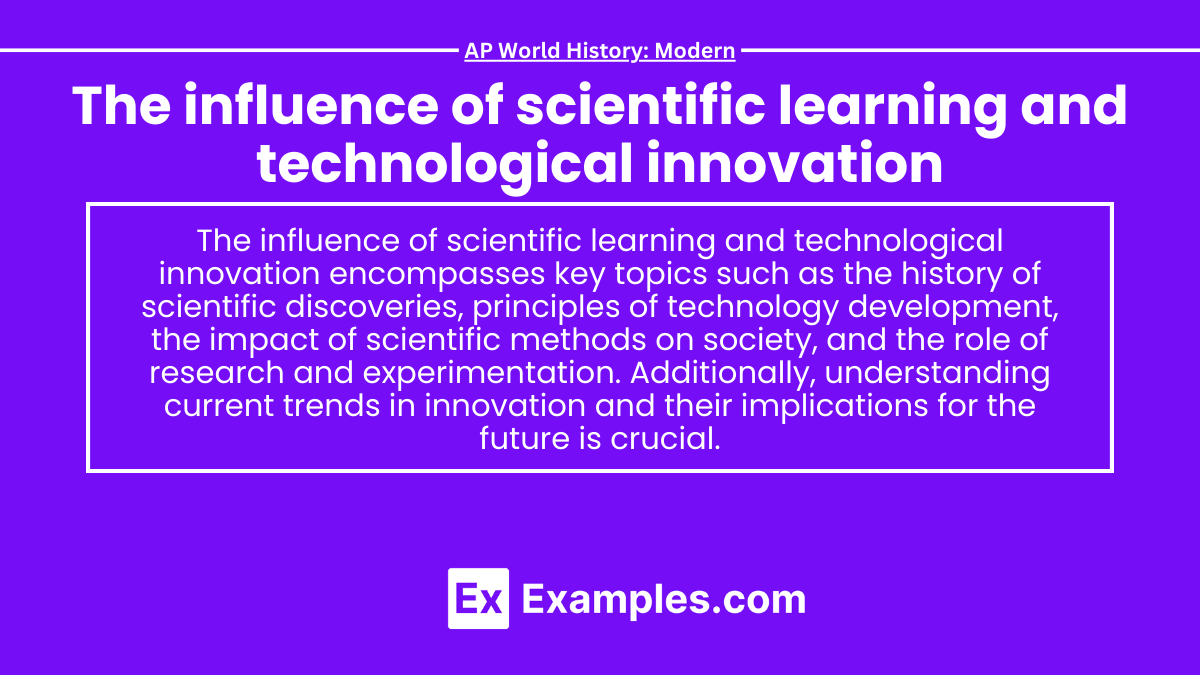The influence of scientific learning and technological innovation from 1450 to the present transformed societies globally. Major developments, such as the Scientific Revolution, Industrial Revolution, and digital advancements, reshaped economies, politics, and daily life. These innovations accelerated exploration, improved communication, and altered labor systems, making science and technology central to historical progress and global interactions.
Learning Objective
In studying Internal and External Challenges to State Power for AP World History: Modern, you should learn to identify the key factors that threaten state authority, including political dissent, economic instability, and social movements within nations. Analyze external pressures such as military conflicts, imperialism, and global economic changes that challenge state sovereignty. Evaluate how states respond to these challenges through reforms, repression, or the adaptation of policies, and explore the long-term consequences of these challenges on state power, governance, and international relations.
1. Renaissance and the Foundations of Scientific Learning
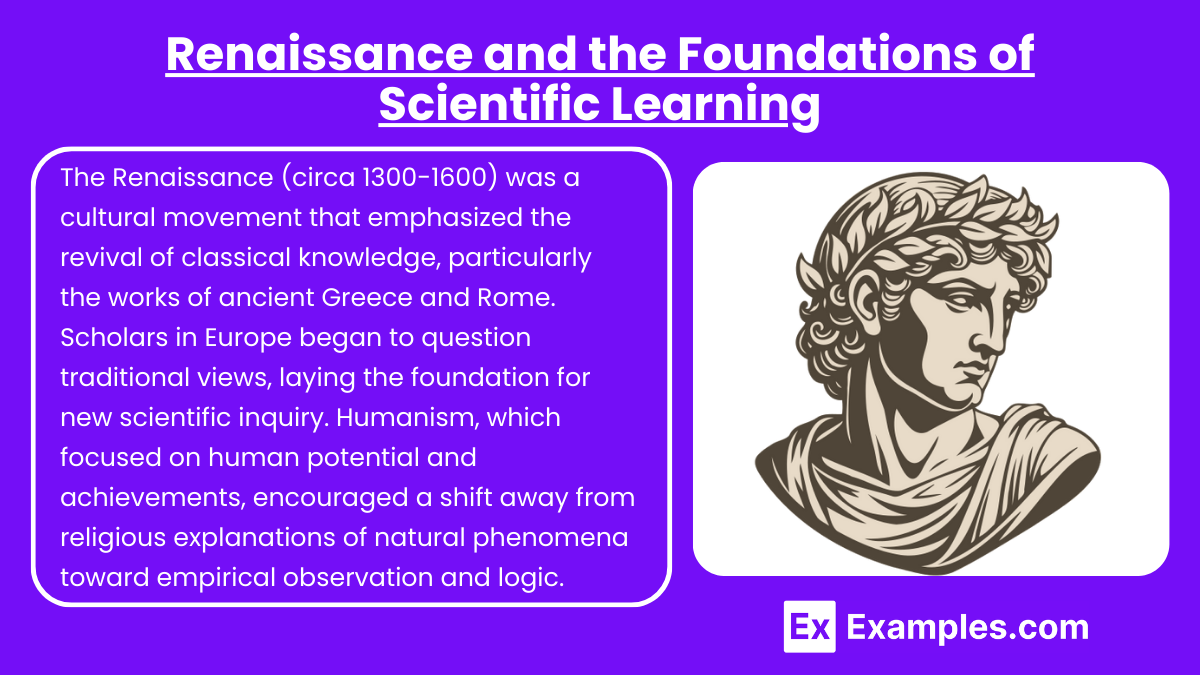
The Renaissance (circa 1300-1600) was a cultural movement that emphasized the revival of classical knowledge, particularly the works of ancient Greece and Rome. Scholars in Europe began to question traditional views, laying the foundation for new scientific inquiry. Humanism, which focused on human potential and achievements, encouraged a shift away from religious explanations of natural phenomena toward empirical observation and logic.
- Leonardo da Vinci exemplified this blending of art and science, conducting detailed studies of anatomy, physics, and engineering.
- Nicolaus Copernicus challenged the geocentric (Earth-centered) view of the universe that had been accepted for centuries by proposing a heliocentric model (Sun-centered), a revolutionary concept that would later lead to conflict with religious institutions.
2. The Scientific Revolution (16th-17th centuries)

The Scientific Revolution was a period of dramatic change in the way people viewed the world. It introduced a new approach to understanding the natural world through observation, experimentation, and reason. This period saw the rise of critical scientific thinkers who laid the foundations for modern science:
- Galileo Galilei improved the telescope and provided strong evidence for Copernicus’s heliocentric theory, challenging the authority of the Church and the long-held Aristotelian view of the cosmos.
- Isaac Newton synthesized the work of previous scientists with his laws of motion and gravity, revolutionizing physics and becoming a key figure in the intellectual landscape.
- Francis Bacon promoted the scientific method, advocating that knowledge should be gained through empirical observation and systematic doubt rather than reliance on tradition and religious dogma.
These advances in scientific thought not only laid the groundwork for fields like physics, astronomy, and chemistry but also fostered a spirit of inquiry and skepticism that would influence the Enlightenment.
3. Technological Innovations and the Age of Exploration (15th-17th centuries)
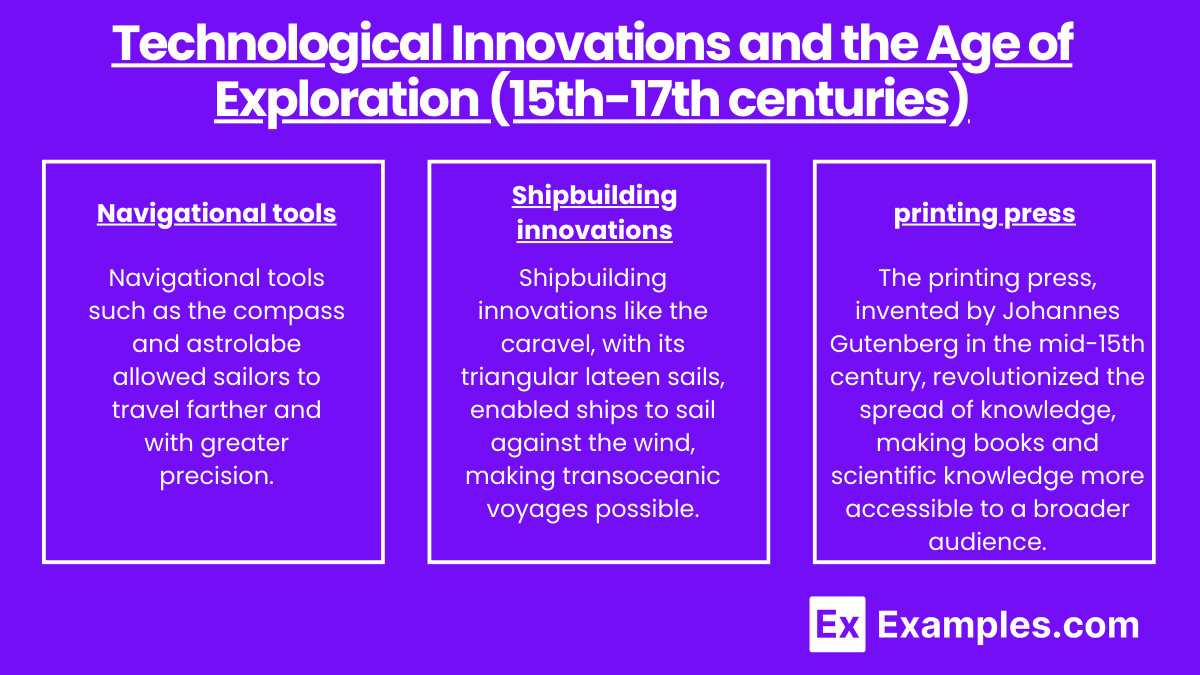
Scientific learning in Europe led to significant technological advancements that enabled exploration and conquest. The Age of Exploration, which began in the 15th century, was driven by a combination of the desire for new trade routes, religious expansion, and technological advancements.
- Navigational tools such as the compass and astrolabe allowed sailors to travel farther and with greater precision.
- Shipbuilding innovations like the caravel, with its triangular lateen sails, enabled ships to sail against the wind, making transoceanic voyages possible.
- The printing press, invented by Johannes Gutenberg in the mid-15th century, revolutionized the spread of knowledge, making books and scientific knowledge more accessible to a broader audience.
These technological innovations allowed European powers like Spain and Portugal to explore, colonize, and exploit new lands, profoundly shaping global trade networks and cultural exchanges, particularly in the Americas, Africa, and Asia.
4. The Industrial Revolution (18th-19th centuries)
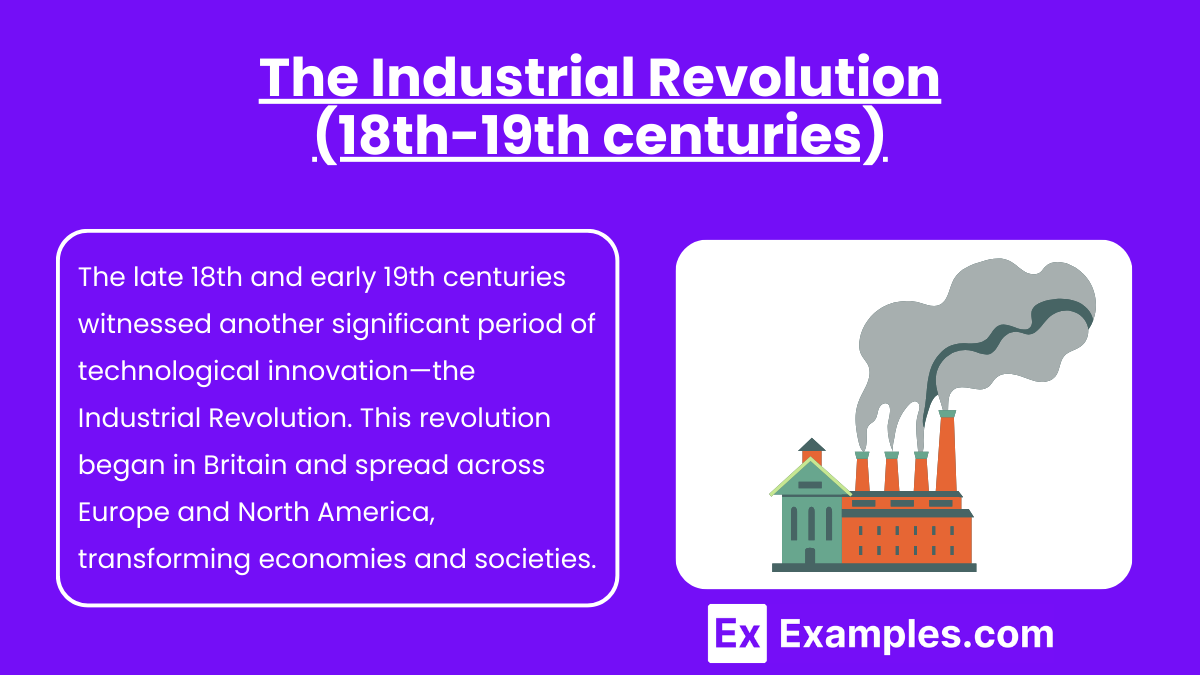
The late 18th and early 19th centuries witnessed another significant period of technological innovation—the Industrial Revolution. This revolution began in Britain and spread across Europe and North America, transforming economies and societies.
- Steam power, especially through James Watt’s steam engine, became a critical force driving the mechanization of production and transportation.
- The development of new machinery in textile manufacturing, such as the spinning jenny and power loom, greatly increased the production of goods, reducing reliance on manual labor.
- Iron and steel production advanced, with the Bessemer process allowing for the mass production of steel, which became critical for building railways, bridges, and industrial machines.
The Industrial Revolution fundamentally changed the global economy, fostering urbanization, creating new social classes, and transforming labor systems. These developments also laid the groundwork for European imperial expansion, as industrialized nations sought raw materials and markets in Africa and Asia.
5. Scientific Advancements in the 19th Century
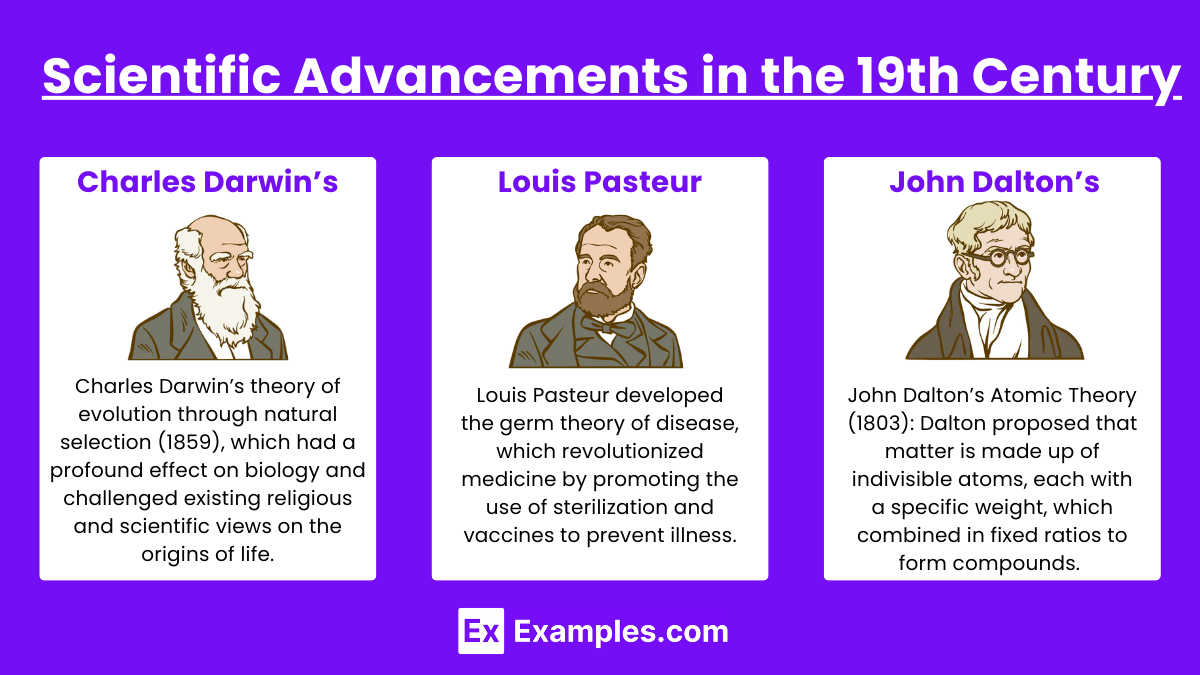
During the 19th century, advances in various scientific fields had a transformative impact on society and industry. Key developments include:
- Charles Darwin’s theory of evolution through natural selection (1859), which had a profound effect on biology and challenged existing religious and scientific views on the origins of life.
- Louis Pasteur developed the germ theory of disease, which revolutionized medicine by promoting the use of sterilization and vaccines to prevent illness.
- John Dalton’s Atomic Theory (1803): Dalton proposed that matter is made up of indivisible atoms, each with a specific weight, which combined in fixed ratios to form compounds. This theory revived and modernized the ancient idea of atomism, setting the stage for modern chemistry.
- Advances in electricity and communication technologies, such as telegraphs, telephones, and electric lighting, changed the way people lived and interacted on a daily basis.
These advancements in scientific understanding not only reshaped medical practices, but also played a crucial role in improving public health and life expectancy.
Examples
Example 1: The Printing Press
Invented by Johannes Gutenberg in the mid-15th century, the printing press revolutionized the spread of knowledge. It made books more affordable and accessible, allowing scientific discoveries and ideas to circulate more widely. This accelerated the Renaissance, Reformation, and Scientific Revolution, enabling scholars to challenge existing knowledge and collaborate across regions.
Example 2: The Steam Engine
The development of the steam engine by James Watt in the late 18th century fueled the Industrial Revolution. It revolutionized transportation and manufacturing, leading to the rise of factories, urbanization, and faster production of goods. This innovation reshaped economies, creating industrial powerhouses in Europe and North America while influencing global trade and colonization.
Example 3: Vaccines and Germ Theory
In the 19th century, the work of scientists like Louis Pasteur led to the development of the germ theory of disease, which revolutionized medicine. Pasteur’s work on vaccines, particularly for rabies, demonstrated the potential of scientific learning in improving public health. This had far-reaching effects, reducing mortality rates and laying the foundation for modern medical practices.
Example 4: The Telegraph and Telephone
In the 19th century, innovations in communication, such as Samuel Morse’s telegraph and Alexander Graham Bell’s telephone, dramatically reduced the time it took to send information across long distances. These technologies accelerated global trade, political diplomacy, and military coordination, contributing to the rise of empires and the modernization of international relations.
Example 5: The Internet and Digital Revolution
The late 20th century saw the rise of the internet and digital technology, fundamentally transforming global communication, trade, and education. The internet allowed for the rapid exchange of information and ideas across the globe, fostering globalization and creating new economic sectors. This innovation continues to shape modern life, from social media to global business operations.
MCQs
Question 1
Which invention is most closely associated with the spread of Renaissance ideas and the Scientific Revolution in Europe?
A) The steam engine
B) The printing press
C) The compass
D) The telegraph
Answer: B) The printing press
Explanation: The printing press, invented by Johannes Gutenberg in the mid-15th century, was a key factor in spreading Renaissance ideas and facilitating the Scientific Revolution. By making books and written materials more accessible, it allowed scholars to disseminate new knowledge widely, fostering intellectual movements and encouraging scientific inquiry. Other inventions like the steam engine and telegraph were important but came much later.
Question 2
Which of the following technological innovations played the most significant role in the Industrial Revolution?
A) The steam engine
B) The compass
C) The astrolabe
D) The printing press
Answer: A) The steam engine
Explanation: The steam engine, developed by James Watt in the late 18th century, was crucial to the Industrial Revolution. It powered machinery in factories, revolutionized transportation (especially railroads and steamships), and increased production efficiency. This innovation led to significant economic changes, including urbanization and industrialization. The other options, such as the compass and astrolabe, were important earlier for navigation and exploration.
Question 3
What was the primary impact of the germ theory of disease developed by scientists like Louis Pasteur in the 19th century?
A) It advanced navigation techniques.
B) It improved manufacturing processes.
C) It revolutionized medical practices and public health.
D) It led to the development of the steam engine.
Answer: C) It revolutionized medical practices and public health.
Explanation: The germ theory of disease, developed by Louis Pasteur and others, fundamentally changed medical science by identifying microorganisms as the cause of many diseases. This led to improved sanitation, the development of vaccines, and better medical practices, greatly reducing mortality rates and improving public health. It had no direct impact on navigation or manufacturing processes.

